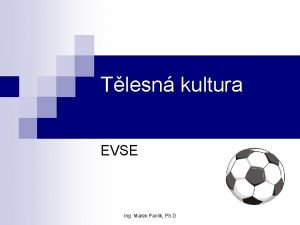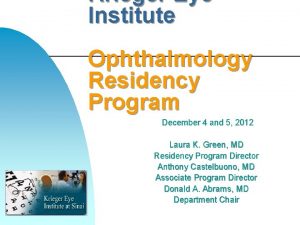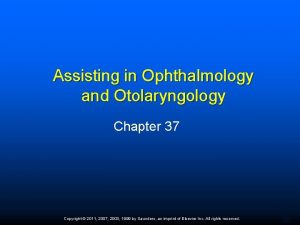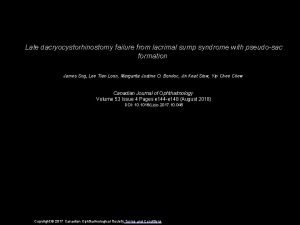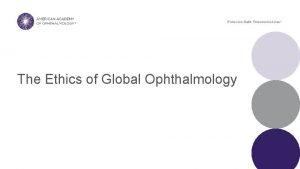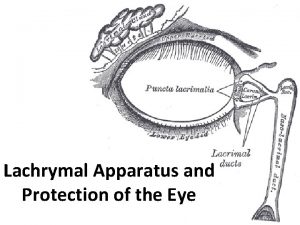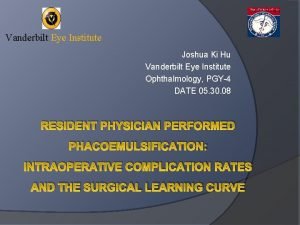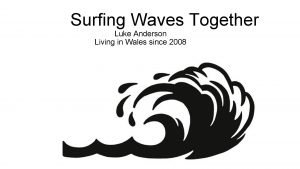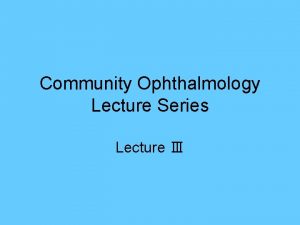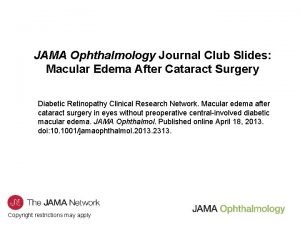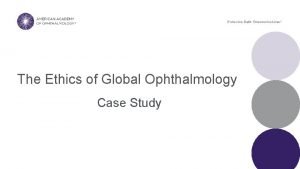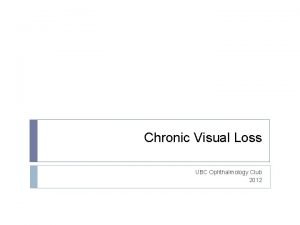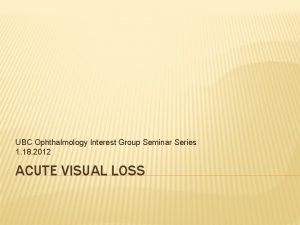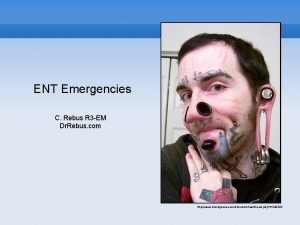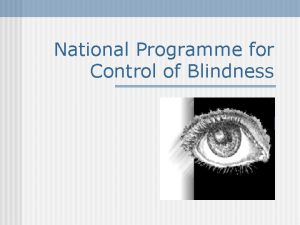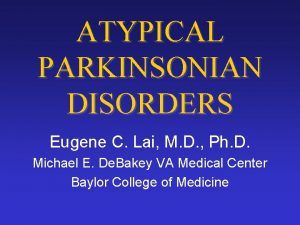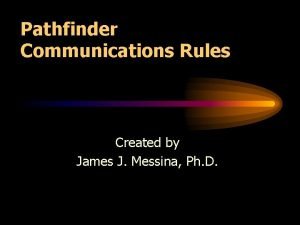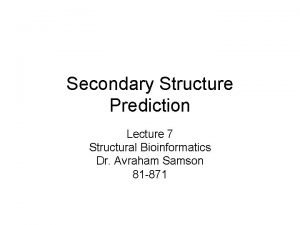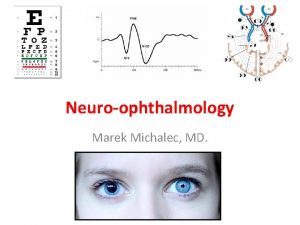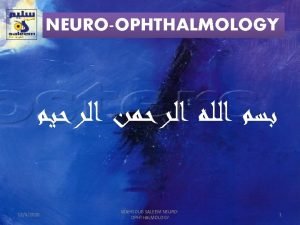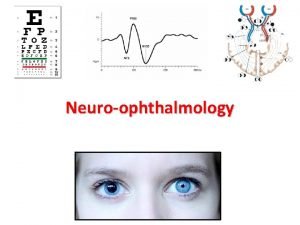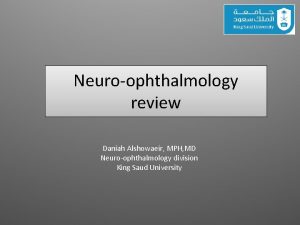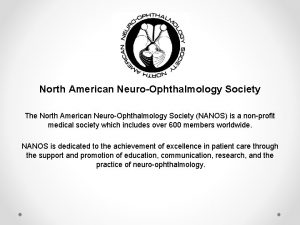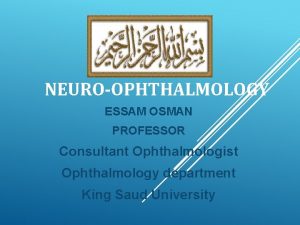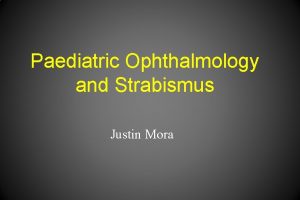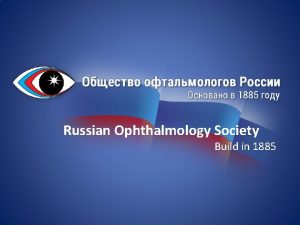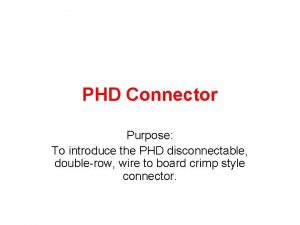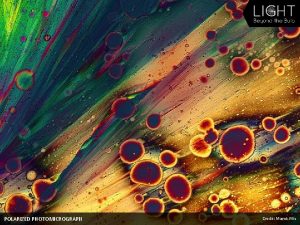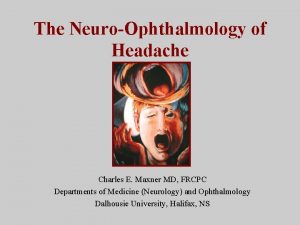Neuroophthalmology MAREK MICHALEC MD PHD Clinic of Ophthalmology






































- Slides: 38

Neuroophthalmology MAREK MICHALEC, MD PHD Clinic of Ophthalmology Faculty Hospital Brno and Masaryk University Version 12/2019

Content • Visual pathway affection • Diseases and affections of optic nerve • Optic chiasm pathology • Pathology of retrochiasmic part • Eye movement disorders • Binocular diplopia • Pupillary reaction abnormalities • Anisocoria • Combined disorders

Examination - part I • Medical history • subjective (visual loss, diplopia) • When it started/ how long lasts it? • Does it change in time/ during the day? • Any progression? • What about the fellow eye? • Other signs? • Personal medical history? • Pharmacological history? • objective (pupillary dysfunction, eye movement disorders, ptosis of upper eyelid, red eye)

Examination - part II • Visual acuity • Without and with correction • Monocular vision / binocular vision • Basic ophthalmological examination • Anterior segment (by slit lamp) • Posterior segment - arteficial mydriasis is essential (indirect ophthalmoscopy) • Visual field examination (static / kinetic perimetry)

Examination - part III • Basic examination (GP) • Neurological examination • Intracranial conditions (including MRI) • neurological signs • Endocrinology • Thyroid associated orbitopathy / ophthalmopathy • Pituitary dysfunction

Examination - part IV • Imaging techniques • Ultrasonography (eye bulb, orbit) • X-ray of skull (orbit, paranasal cavities) • Computerised Tomography of head (brain, skull bones, orbital bones) • MRI of head (brain, orbital structures)

Optic nerve disorders Clinical signs • Visual aquity decrease • Visual field defect Division: • Congenital • developmental anomalies • Acquired • inflammation – optic neuritis • Non-inflammation – ischemic neuropathy (anterion, posterior) • Genetic relatives • LHON (Leber hereditary optic atrophy)

Optic disc oedema = papilledema in general • Causes • Elevated intracranial pressure – tumor, idiopathic intraxcranial pressure, hydrocephalus • Optic nerve affection – optic neuritis, neuropathy • Clinical picture • elevation of optic disc, diminished margins • loss of physiological excavation • swelling of peripapillary retinal nerve fiber layer • optic disc hyperemia • dilatation and tortuosity of vessels • Haemorrhagies, cotton wool spots Papilledema (idiopathic intracranial hypertension)

Papilledema • cause – elevated intracranial pressure • 75% of cases – intracranial tumor!!! • bilateral condition, often assymetric • faster onset in young people • mostly without subjective signs • sometimes blurred vision • enlargement of blind spot

Optic neuritis Clinical picture Types • unilateral condition • intraocular • fast onset (hours) • retrobulbar – most common • loss of visual acuity • retrobulbar pain – patognomical sign Prognosis • color vision defects • usually good – regression after intravenous corticoids • visual field defects Epidemiology Causes • 20 -40 years of age • demyelinisation – most common (multiple sclerosis) • female/male: 2 -3/1 • infection / parainfection • paraneoplastic • Strong association with MS • 20% of cases – first sign of MS • 50% pacients with MS – manifestation of ON during the disease

Optic neuritis diagnosis VEP: delayed latency P 100 MRI: optic neuritis

Anterior ischemic optic neuropathy • most common optic nerve affection in advanced age • unilateral condition Cause – affection of short ciliar arteries Epidemiology • 50 years of age and more Clinical picture • loss of visual acuity - fast onset, painless (light perception to almost normal values) • monocular visual field defect – altitudinal scotoma • unilateral ischemic optic disc oedema

Anterior ischemic optic neuropathy Arteritic form (10 – 15 % of all cases) – less common, more serious • Risk factors: association with systemic vasculitis (giant-cell arteritis = Horton disease) • Clinical picture: loss on weight, headache, jaw claudication, tenderness and sensitivity on the scalp) • very high sedimentation rate - over 100 per hour, temporal artery biopsy • High risk of affection of fellow eye (days, weeks) – immediate therapy!!! • Therapy: high dosage of intravenous corticoids Nonarteritic form (85 – 90 % of all cases) • Risk factors: hypertension, diabetes, dyslipidemia, smoking, obesity • Therapy: N/A, compensation of all systemic diseases Temporal artery in GCA

Optic nerve atrophy • Irreversible loss of axons • After various optic nerve affections Etiology • Primary – posttraumatic, by direct pressure of tumor • Secondary – affection of optic nerve (ischemia, inflammation) • Glaucomatous – elevates intraocular pressure Clinical picture • Pale optic disc • Reduction of smaller vessels

Anatomy of visual pathway

Anatomy of visual pathway Anatomie zrakové dráhy

Visual field defects Optic nerve • monocular visual field defects Optic chiasm • bilateral heteronymn visual field defects Optic tract • bilateral homonymn visual field defects Geniculocalcarine tract • bilateral visual field defects often with central sparing

Specific visual field defects with correlation to visual pathways Physiological visual field Bitemporal hemianopsia Binasal hemianopsia Left sized homonymn hemianopsia Right sized homonymn hemianopsia

Chiasmal syndrome • lesions in chiasmal area • typically compressive, expansive condition • typical visual field defects – use in diagnosis • causes: • Pituitary adenomas • Craniopharyngioma • Meningioma • Aneurysm

Pituitary adenoma • benign tumor of pituitary gland • classification • by size – microadenoma (up to 10 mm), macroadenoma (more than 10 mm) • biological activity – benign adenoma, invasive adenoma, adenocarcinoma • possibility of metabolical activity (e. g. prolactinom) a • compression and lesion of optic chiasm by tumor growth – bitemporal hemianopsia – starting as upper kvadrantanopsia • therapy • conservative – hormone inhibition (Cabergolin, Octreotid) • surgical - resection (endonasal, transsphenoidal adenectomy)

Craniopharyngioma • benign rare type of tumor from pituitary gland embryonal tissue • pressure on nearby tissue, typical visual field defects – bitemporal hemianopsia – first starting as lower quadrantanopsia • therapy • surgical - transsphenoidal adenectomy) • radiotherapy

Meningioma • slow growing tumor from meninges • tumor growth, pressure on nearby tissue, typical visual field defects depending on location • therapy • surgical • radiotherapy

Anatomy of eye movement system • 4 recti muscles: • medial rectus m. • lateral rectus m. • inferior rectus m. • superior rectus m. • 2 oblique muscles: • superior oblique m. • inferior oblique m.

Eye movement disorders • Isolated palsies • oculomotor nerve palsy • trochlear nerve palsy • abducent nerve palsy • Ophthalmoplegia • combined disorders (affection of 2 or 3 nerves) • cavernous sinus syndrome • orbital apex syndrome • carotido-cavernous fistula

Isolated palsies • Oculomotor nerve palsy– aneurysm (most common), less common tumor, trauma, ischemia • Trochlear nerve palsy – most common trauma (fall on head), less common ischemia of braistem, tumor, half of cases idiopathic • Abducent nerve palsy – mostly trauma, ischemia (diabetes), intracranial hypertension (sometimes first manifestation), less common tumor or idiopathic

Oculomotor nerve palsy • Upper eyelid ptosis • Abduction of affected eye • Eye movement disorder – multiple sizes of gaze (nasal, up, down) • Diplopia (mixed – horizontal and vertical) • Anisocoria (mydriasis on affected size)

Trochlear nerve palsy • Diplopia – vertical, major manifestation in downgaze, bigger turning back, walking downstairs) • Compensation head posture (Torticollis) – chin turning down, head posture at non affected size • Eye movement disorder – affected eye upgaze, not necessary visible!

Abducent nerve palsy • Diplopia – typically horizontal, major manifestation in gaze to affected size • Compensation head posture – head turned on affected size • Eye movement disorder – adduction of affected eye o straight position, abduction insufficiency on affected size

Cavernous sinus syndrome • Etiology • Expansive / infiltrative condition in cavernous sinus (thrombosis, tumor, metastasis, aneurysm) • Affection of oculomotor, trochlear, abducent, trigeminal nerve (1. or 2. branch) • Clinical picture • Upper eyelid ptosis • Ophthtalmoplegia (incomplete / complete) • Diplopia • Plegic pupil / mydriasis • Exophthalmus • pain / hypestesia meningioma

Orbital apex syndrome • Etiology • expansive / infiltrative condition in orbital apex (tumor, metastasis, orbitocellulitis, infection) • Affeof oculomotor, trochlear, abducent, trigeminal nerve and also optic nerve • Clinical picture • Upper eyelid ptosis • Ophthalmoplegia (incomplete / complete) • Visual acuity decrease – diplopia (undirectly to level of visual acuity) • Exophthalmus • Hypestesia (inervation area of 1. and 2. branch of trigeminal nerve) Aspergillus infection

Carotid-cavernous fistula • Etiology • abnormal communication between arterial and venous system within the cavernous sinus • direct – post traumatic; rupture of ICA wall • indirect – rupture of smaller vessels • Clinical picture • Caput medusae, bruit, feeling of pulsation, eye movement disorder, diplopia, Caput medusae infekce CT contrast: dilatation. Aspergillova of ophthalmic vein exophthalmus, elevated intraocular pressure, decreased visual acuity • Therapy • endovascular – transarterial or transvenous (stent, coil, balloons) Angiography: communication fistula After embolisation

Pupilomotoric pathway Aspergillova infekce Parasympathetic pathway Angiografie: komunikace - Sympathetic fistula pathway Stav po embolizaci

Pupillary reactions • Basic reactions • Mydriasis – sympathetic inervation (m. dilatator pupilae) • Miosis – parasympathetic inervation (m. sphincter pupilae) • Diagnostic tests • Direct and undirect shine (action-reaction) – physiological miosis of both pupils • Near response test – physiological miosis associated with accomodation • Farmacological testing Angiografie: komunikace - fistula Stav po embolizaci

Pupillary reactions • Typical pupil appearance • isocoria (physiological anisocoria up to 1 mm – same size in various illuminance) • consensual reaction of both pupils • size – diameter 3 mm, dependence on authonomic nervous system • Atypical appearance or pupilar reaction • Pupilotonia (Adie´s pupil) – dilated pupil not responding to light, worm-like movement within the pupil, accomodation disorder, diminished patellar reflex and Achilles tendon reflex • Argyll-Robertson pupil – narrow pupil with no reaction to light, preserved accomodation (syphilis, neuropathy, diabetes) • Anisocoria – inequal size of pupils (more than 1 mm), often random finding, may be physiological (up to 1 mm) Angiografie: komunikace - fistula Stav po embolizaci

Anisocoria – diagnostic scheme Which pupil is pathological? light dark

Anisocoria – diagnostic scheme light dark 0, 1% Pilocarpin 10% cocaine Adie´s pupil 1 -2% Pilocarpin Oculomotor nerve palsy Horner syndrome Arteficial mydriasis Fyziological anisocoria Stav po embolizaci

Horner syndrome Signs • Miosis (no mydriasis in dark) • Ptosis of upper eyelid • Pseudoenoftalmus • Anhidrosis (diminished sweating of half part of face) • Heterochromia (congenital form only) Etiology • Trauma, dissecion of internal carotid artery, ischemiea of brain stem, multiple sclerosis, intracranial tumor, syringomyelia, Pancoast tumor (lung apex tumor), goiter, thyroid carcinoma. . . but mostly idiopathic! Angiografie: komunikace - fistula Stav po embolizaci

Thanks for your attention!
 Miosis vs mydriasis
Miosis vs mydriasis Dr briar sexton
Dr briar sexton Ing marek pavlik phd
Ing marek pavlik phd Sinai baltimore ophthalmology residency
Sinai baltimore ophthalmology residency 16710-17
16710-17 Chapter 31 ophthalmology and otolaryngology
Chapter 31 ophthalmology and otolaryngology Sump syndrome
Sump syndrome Vasculopata
Vasculopata Thym adren
Thym adren Alan bird ophthalmology
Alan bird ophthalmology Ethics in global ophthalmology
Ethics in global ophthalmology Veterinary ophthalmology
Veterinary ophthalmology Vanderbilt ophthalmology residency
Vanderbilt ophthalmology residency Asia-pacific academy of ophthalmology
Asia-pacific academy of ophthalmology Luke anderson ophthalmology
Luke anderson ophthalmology Ophthalmology
Ophthalmology Ophthalmology lecture
Ophthalmology lecture St. john's episcopal hospital ophthalmology residency
St. john's episcopal hospital ophthalmology residency Jama ophthalmology impact factor
Jama ophthalmology impact factor Ophthalmology case study
Ophthalmology case study Ubc ophthalmology
Ubc ophthalmology Ubc ophthalmology
Ubc ophthalmology Dr rebus
Dr rebus Dbcs in ophthalmology
Dbcs in ophthalmology Eugene lai md
Eugene lai md Revv mac phd
Revv mac phd Niels fuglsang phd
Niels fuglsang phd James messina phd
James messina phd Phd in name
Phd in name Lisa brenner phd
Lisa brenner phd Craig watson md phd
Craig watson md phd Kathleen brehony
Kathleen brehony Phd secondary structure prediction
Phd secondary structure prediction Doc. firment
Doc. firment Rebecca sutton phd
Rebecca sutton phd Karim dahia phd
Karim dahia phd Amy bunger phd
Amy bunger phd Psychology major towson
Psychology major towson Time schedule phd proposal
Time schedule phd proposal


